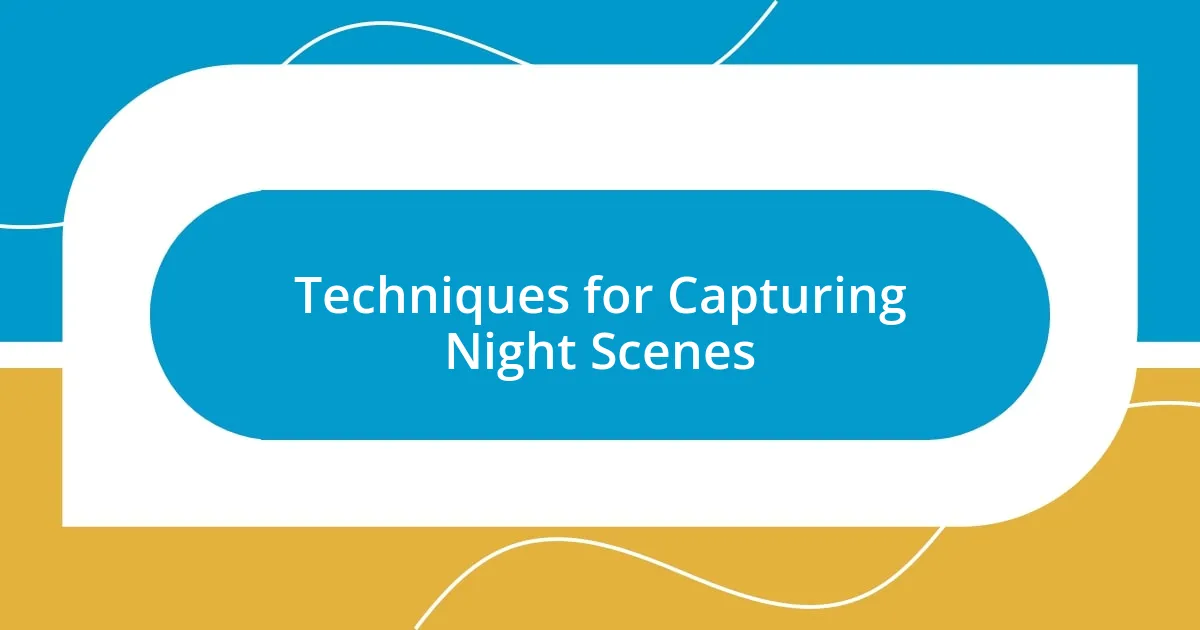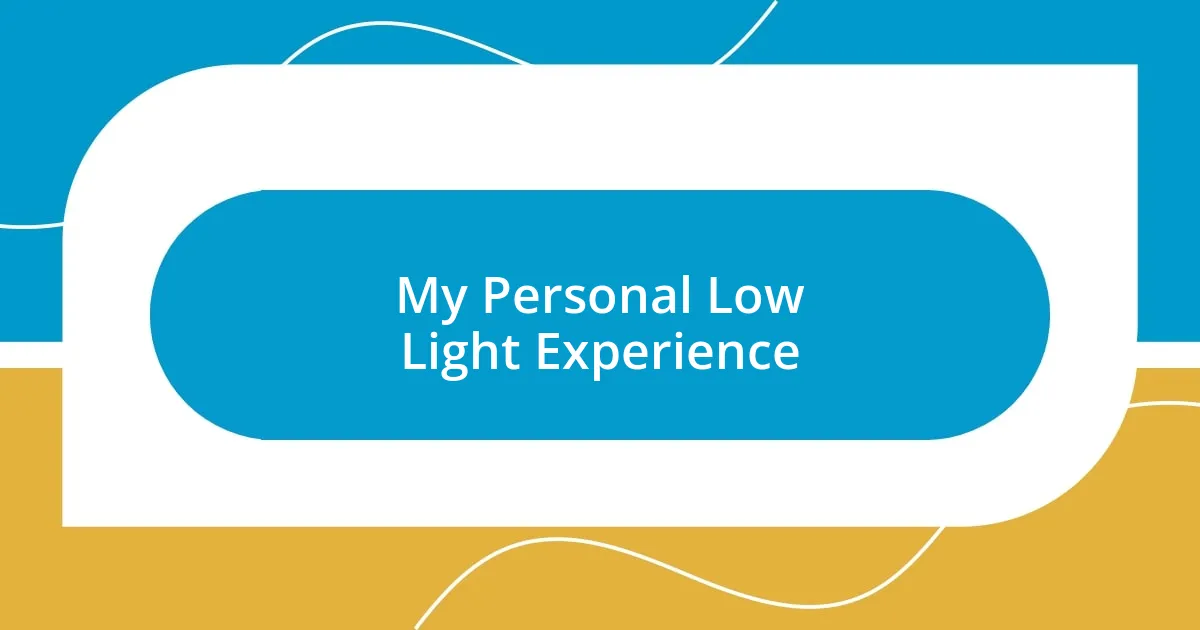Key takeaways:
- Low light photography requires understanding light conditions and may involve using a tripod, adjusting shutter speed, and increasing ISO to avoid blurry images.
- Essential gear includes a sturdy tripod, a fast lens (wide aperture), and an external flash to enhance image quality and control lighting.
- Camera settings such as slow shutter speed, higher ISO, wide aperture, and manual white balance are critical for capturing clear photos in low light.
- Post-processing techniques like noise reduction and adjusting contrast can significantly enhance low light images, bringing out detail and vibrancy.

Understanding Low Light Photography
Low light photography is more than just snapping photos in dimly lit environments; it’s an art form that challenges you to push your creative boundaries. I remember the first time I ventured out at night with my camera, feeling the excitement—and a bit of anxiety—of capturing the world in a different light, quite literally. Have you ever felt that electric thrill when you see a scene transform from ordinary to magical under the glow of streetlamps?
In low light conditions, the game changes dramatically. The camera captures less light, which means you often have to slow down your shutter speed or increase the ISO. I recall a night shoot in the city where I had to experiment with these settings to avoid blurry images and graininess. This learning curve taught me the importance of stability; a tripod became my best friend, stabilizing my shots and allowing longer exposures that revealed details I never would have noticed otherwise.
Embracing low light photography also means understanding light quality and direction. The soft halos of light around subjects create moods that are simply impossible to replicate in daylight. Have you ever looked at a photograph and felt the stillness of the night? I once took a shot of a quiet alley bathed in moonlight; the shadows danced around the corners, evoking a sense of solitude and peace that resonated deeply with me. Those moments remind me that sometimes, it’s the shadows that tell the most compelling stories in our photographs.

Essential Gear for Low Light
When it comes to essential gear for low light photography, having the right equipment is crucial. First and foremost, a sturdy tripod can make all the difference. I recall a night when I forgot mine; I struggled to capture a breathtaking view of the city lights. The blurry images still elude me—what a missed opportunity! A tripod stabilizes your camera, allowing longer exposure times without the risk of shake, which is invaluable for those dreamy night shots.
Another game-changer in low light settings is using a fast lens—specifically, one with a wide aperture like f/1.8 or f/2.8. These lenses allow more light to hit the sensor, producing sharper images even in dim conditions. I once shot a local band in a dark venue with my f/1.8 lens, and the vivid colors and details of the performance blew me away. Fast lenses not only enhance image quality but also create that beautiful depth of field, making your subjects pop against soft backgrounds.
Don’t overlook a good external flash or light source, either. I learned this the hard way during a twilight shoot in a park; my camera’s built-in flash just didn’t cut it. An external flash allowed me to illuminate my subjects without overpowering the ambient light, resulting in a more balanced exposure. It’s all about harnessing the available light creatively, and I find that experimenting with gear can lead to unexpected and fantastic results.
| Gear | Purpose |
|---|---|
| Tripod | Stabilizes camera for longer exposures, reducing blur. |
| Fast Lens (f/1.8 or f/2.8) | Allows more light in, improving image quality in low light. |
| External Flash | Provides additional light source for better subject illumination. |

Camera Settings for Low Light
In low light photography, tweaking your camera settings is crucial for capturing those magical moments. Reducing shutter speed can help, but it also requires a steady hand—or ideally, a tripod. I remember watching in awe as the city skyline came to life, all while keeping my ISO reasonable to avoid grainy shots. It felt like a balancing act, adjusting my settings on the fly to make the most of the ambient light.
Here’s a quick guide on important camera settings to consider in low light:
- Shutter Speed: Aim for slower speeds (e.g., 1/60 or longer), but be cautious of motion blur.
- ISO: Start with 800-1600; feel free to increase it, but monitor the noise levels.
- Aperture: Use the widest setting, like f/1.8 or f/2.8, to capture more light.
- White Balance: Set it manually to match the light source for accurate colors.
- Shooting Mode: Prefer Aperture Priority (Av) or Manual for better control.
Getting these settings right has the potential to transform your low light experience. I still close my eyes and visualize that shot of the bustling street market at dusk. With my camera’s settings dialed in, the atmosphere felt alive—perfectly capturing the magic of the moment.

Techniques for Capturing Night Scenes
Capturing night scenes is truly an art form, and one technique I often turn to is long exposure photography. I vividly remember a night at a nearby beach, where I set my shutter speed to around 15 seconds. The waves transformed into soft, silky trails of light, creating an ethereal mood. However, I always ask myself: how much light is just right? Finding that sweet spot can lead to breathtaking results, but it takes practice.
Another aspect to consider is focusing in low light. I once faced the challenge of photographing fireflies in a dark garden. It was tricky, but switching to manual focus allowed me to pinpoint exactly where I wanted to capture that magical glow. This experience taught me the importance of patience and perseverance. Do you ever struggle with focusing at night? Trust me; it’s a journey that pays off when you finally nail that perfect shot.
Lastly, I’ve found that incorporating light sources into your composition can add depth and interest. During one evening shoot, I positioned myself near an old lamppost that cast a warm glow. The contrast of the soft light against the cool blues of twilight made for a stunning scene. I often think about how simple elements, like a lamp or the glow of city lights, can completely transform a photo. Have you tried experimenting with ambient light in your night shots? It’s amazing how it can set the mood and elevate your photography to the next level.

Post Processing Low Light Images
Post-processing low light images can really make a difference in bringing out the best in your photos. I often find myself diving into editing software after a shoot, particularly to brighten shadows and enhance colors that can sometimes appear muted in low light. I recall a night where I shot a street musician playing under a dim streetlight. In post-processing, I adjusted the exposure slightly, bringing out the vibrant colors of the musician’s clothing and the warm glow of the light, which transformed the entire atmosphere.
One technique I swear by is noise reduction. Low light conditions can lead to grainy images, which may detract from the beauty of your shot. After applying a gentle noise reduction filter to a photo of fireworks I captured on New Year’s Eve, I was astonished at how smooth and crisp the final image turned out. It’s like revealing hidden layers of a painting; have you ever felt that excitement when seeing a photo come alive in editing? It’s a rewarding part of the process that can elevate an average photo to something extraordinary.
I also love experimenting with contrast and clarity adjustments to give depth to my low light images. I remember editing a hauntingly beautiful shot of an empty street after rain, where dark puddles reflected the dim glow of streetlights. Increasing contrast made the reflections pop, drawing the viewer’s eye and evoking a sense of solitude. I continually ask myself, how can I guide the viewer’s emotion through this image? Working through these adjustments feels like storytelling, and every slider brings me closer to the narrative I want to convey.

My Personal Low Light Experience
I remember my first real foray into low light photography during a city festival. Armed only with my camera, I wandered through the vibrant streets lit by strings of colorful lights. The atmosphere was electric, but I quickly discovered how challenging it could be to capture that energy. I ended up with a series of blurry images, which initially felt disheartening, but it sparked an insatiable curiosity within me. How do you freeze a moment in time when the light is so low? It’s a puzzle that I have learned to embrace, and it keeps me coming back for more.
On another occasion, I found myself at an old, abandoned warehouse just as the sun dipped below the horizon. The shadows crept in, swallowing the details of the architecture, but I saw potential in the darkness. I set my aperture wider and slowed down my shutter speed to let in more light. As I adjusted my settings and peered through the lens, the scene transformed—rusting metal beams glimmered with what little light remained. I felt like an explorer discovering hidden treasures, and it made me think: isn’t it fascinating how the right settings can breathe life into forgotten places?
One night, I stood on a bridge, capturing the reflection of city lights dancing on the water. A cool breeze swept by, and I could hear the distant laughter from a nearby group of friends enjoying their evening. In that moment, I realized photography is not just about showcasing a scene; it’s about capturing the essence of an experience. I think to myself, what stories do these images hold? It felt like I was freezing emotions in time, and that’s what keeps me passionate about low light photography.














